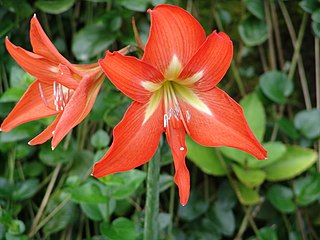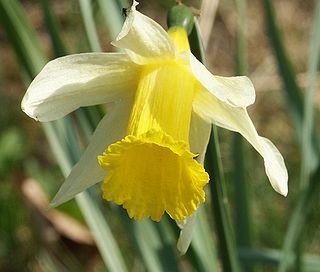
List of flower bulbs is a list of flowering plants which come from ornamental bulbs. Most flower bulbs produce perennial flowers and in cold zones the bulbs are left in the ground year-round.

List of flower bulbs is a list of flowering plants which come from ornamental bulbs. Most flower bulbs produce perennial flowers and in cold zones the bulbs are left in the ground year-round.
Flowering plant bulbs are planted beneath the surface of the earth. The bulbs need some exposure to cold temperatures for 12 to 14 weeks in order to bloom. [1] Flower bulbs are generally planted in the fall in colder climates. The bulbs go dormant in the winter but they continue to absorb water and nutrients from the soil and they develop roots. [2] Most bulbs produce perennial flowers. Occasionally certain bulbs become crowded in the ground and they must be removed and separated. These include: amaryllis (Hippeastrum spp.) and cyclamen (Cyclamen persicum). [3]
Some flower bulbs do well in hot climates: Lilies, Caladiums, Dahlias, Gladiolus, Narcissus (plant) and daffodils. To grow cold weather flower bulbs like Tulips and crocus in hot climates, gardeners must dig up the bulbs and store them in the cold for 3-4 months before replanting. [4]
In addition to flowers, some vegetables have bulbs and they include, garlic, Onions and shallots. Some other plant roots which bear a similarity to bulbs include: corms, tubers, tuberous roots and rhizomes. [3]

Amaryllis is the only genus in the subtribe Amaryllidinae. It is a small genus of flowering bulbs, with two species. The better known of the two, Amaryllis belladonna, is a native of the Western Cape region of South Africa, particularly the rocky southwest area between the Olifants River Valley and Knysna.

In botany, a bulb is structurally a short stem with fleshy leaves or leaf bases that function as food storage organs during dormancy.

Narcissus is a genus of predominantly spring flowering perennial plants of the amaryllis family, Amaryllidaceae. Various common names including daffodil, narcissus and jonquil, are used to describe all or some members of the genus. Narcissus has conspicuous flowers with six petal-like tepals surmounted by a cup- or trumpet-shaped corona. The flowers are generally white and yellow, with either uniform or contrasting coloured tepals and corona.

Hippeastrum is a genus of about 90 species, and over 600 hybrids and cultivars, of perennial, herbaceous and bulbous plants, native to tropical and subtropical regions of the Americas, from Mexico south to Argentina and on some islands in the Caribbean. The majority have large, fleshy bulbs—usually about the size of a softball—and tall, broad, strap-like leaves that are (generally) evergreen, and large red or purple flowers. Numerous colors and cultivars have been created over the past hundred years.

Crinum is a genus of about 180 species of perennial plants that have large showy flowers on leafless stems, and develop from bulbs. They are found in seasonally moist areas, including marshes, swamps, depressions and along the sides of streams and lakes in tropical and subtropical areas worldwide.
A storage organ is a part of a plant specifically modified for storage of energy (generally in the form of carbohydrates) or water. Storage organs often grow underground, where they are better protected from attack by herbivores. Plants that have an underground storage organ are called geophytes in the Raunkiær plant life-form classification system. Storage organs often, but not always, act as perennating organs which enable plants to survive adverse conditions.

Amaryllis belladonna, the Jersey lily, belladonna-lily, naked-lady-lily, or March lily, is a plant species native to Cape Province in South Africa but widely cultivated as an ornamental. It is reportedly naturalized in many places: Corsica, Portugal, the Azores, Madeira, the Canary Islands, the Scilly Isles of Great Britain, the Democratic Republic of the Congo, Ascension Island, Australia, New Zealand, Mexico, Cuba, Haiti, the Dominican Republic, Chile, California, Texas, Louisiana, Mississippi, Michigan and the Juan Fernández Islands.

Narcissus pseudonarcissus, commonly named the wild daffodil or Lent lily, is a perennial flowering plant.
The Koninklijke Algemeene Vereniging voor Bloembollencultuur, translated from Dutch as the Royal General Association for Bulb Culture, but more commonly known world-wide by the acronym of KAVB, is a trade association for the bulb horticulture sector, and was established in 1860. The association has a rural organization, within which regional groups and departments are active.

Sprekelia is a genus of Mesoamerican plants in the Amaryllis family, subfamily Amaryllidoideae. Sprekelia plants are sometimes called Aztec lilies or Jacobean lilies although they are not true lilies. This genus has been submerged in Zephyranthes, but as of January 2023 is accepted by Plants of the World Online with a single species, Sprekelia formosissima, endemic to Mexico.
The Botanischer Garten Solingen is a 6-hectare (15-acre) botanical garden located at Vogelsang 2a, Solingen, North Rhine-Westphalia, Germany. It is open daily without charge.

Ornamental bulbous plants, often called ornamental bulbs or just bulbs in gardening and horticulture, are herbaceous perennials grown for ornamental purposes, which have underground or near ground storage organs. Botanists distinguish between true bulbs, corms, rhizomes, tubers and tuberous roots, any of which may be termed "bulbs" in horticulture. Bulb species usually lose their upper parts during adverse conditions such as summer drought and heat or winter cold. The bulb's storage organs contain moisture and nutrients that are used to survive these adverse conditions in a dormant state. When conditions become favourable the reserves sustain a new growth cycle. In addition, bulbs permit vegetative or asexual multiplication in these species. Ornamental bulbs are used in parks and gardens and as cut flowers.

Brithys crini, the amaryllis borer, crinum borer, lily borer or Kew arches, is a moth of the family Noctuidae. It is a garden pest in parts of its range, as their larvae damage the stems and leaves of lilies, especially lilies of the family Amaryllidaceae.

Nerine bowdenii is a species of flowering plant in the family Amaryllidaceae. It is an herbaceous bulbous perennial, growing to 45 cm (18 in) tall by 8 cm (3 in), with strap-shaped leaves and large umbels of lily-like pink flowers in late summer and autumn. The common names of the species are Cornish lily, Cape flower, Guernsey lily, and Bowden lily. However, it is neither a true lily nor from Cornwall or Guernsey, but originates from South Africa. Confusingly the name “Guernsey lily” is also applied to a related species, Nerine sarniensis.

Cut flowers are flowers and flower buds that have been cut from the plant bearing it. It is removed from the plant for decorative use. Cut greens are leaves with or without stems added to the cut flowers for contrast and design purposes. These displays improve the quality of the human environment.

Theodore Luqueer Mead was an American naturalist, entomologist and horticulturist. As an entomologist he discovered more than 20 new species of North American butterflies and introduced the Florissant Fossil Beds in Colorado to the wider scientific world. As a horticulturist, he is best known for his pioneering work on the growing and crossbreeding of orchids, and the creation of new forms of caladium, bromeliad, crinum, amaryllis and hemerocallis (daylily). In addition, he introduced many new semi-tropical plants, particularly palm varieties, into North America. A comprehensive historical biography of his life and times was published in 2017.
The de Graaff brothers were a Dutch horticultural family company based in Lisse, Netherlands, in an area known as Duin- en Bollenstreek, the centre of the Dutch bulb and floriculture industry.
Peyronellaea curtisii is a fungal plant pathogen first described by Miles Joseph Berkeley and received its current name in 2010. Formerly it was Stagonosporacurtisii. It is a cause of leaf blotch, and its substrates include Narcissus, Galanthus and Hippeastrum.
The Asparagales are an order of plants, and on this page the structure of the order is used according to the APG III system. The order takes its name from the family Asparagaceae and is placed in the monocots. The order is clearly circumscribed on the basis of DNA sequence analysis, but is difficult to define morphologically, since its members are structurally diverse. The APG III system is used in World Checklist of Selected Plant Families from the Royal Botanical Gardens at Kew. With this circumscription, the order consists of 14 families with approximately 1120 genera and 26000 species.